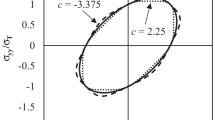Abstract
A semi-analytical solution of the problem of compression of a tube by an outer pressure with subsequent unloading is obtained. The effect of the relationship between the shear modulus and plastic strain on the residual stress and strain was evaluated using experimental data, according to which at an accumulated plastic strain of 0.25, the shear modulus decreases by 20%. It is found that despite the significant decrease in the shear modulus, its dependence on the accumulated strain has no significant effect on the residual strain. The effect of this dependence is manifested mainly in the distribution of the residual radial stress, but, in this case, too, it is extremely weak. The obtained general solution can be used to evaluate the effect of the relationship between the shear modulus and the accumulated plastic strain on the residual stress and strain for other materials.
Similar content being viewed by others
References
K. P. Li, W. P. Carden, and R. H. Wagoner, “Simulation of Springback,” Int. J. Mech. Sci. 44, 103–122 (2002).
L. Geng and R. H. Wagoner, “Role of Plastic Anisotropy and Its Evolution on Springback,” Int. J. Mech. Sci. 44, 123–148 (2002).
J.-T. Gau and G. L. Kinzel, “An Experimental Investigation of the Influence of the Bauschinger Effect on Springback Predictions,” J. Mater. Process. Technol. 108, 369–375 (2001).
W. L. Xu, C. H. Ma, C. H. Li, and W. J. Feng, “Sensitive Factors in Springback Simulation for Sheet Metal Forming,” J. Mater. Process. Technol. 151, 217–222 (2004).
S. M. Roberts, F. R. Hall, A. V. Bael, et al., “Benchmark Tests for 3-D, Elasto-Plastic, Finite-Element Codes for the Modeling of Metal Forming Processes,” J. Mater. Process. Technol. 34, 61–68 (1992).
K. Yamaguchi, H. Adachi, and N. Takakura, “Effects of Plastic Strain and Strain Path on Young’s Modulus of Sheet Metals,” Metals Mater. 4(3), 420–425 (1998).
M. Yang, Y. Akiyama, and T. Sasaki, “Evaluation of Change in Material Properties Due to Plastic Deformation,” J. Mater. Process. Technol. 151, 232–236 (2004).
R. Hill, Mathematical Theory of Plasticity (Clarendon Press, Oxford, 1950).
A. Mendelson, Plasticity: Theory and Application (Macmillan, New York, 1968).
V. V. Sokolovskii, Theory of Plasticity (Vysshaya Shkola, Moscow, 1969) [in Russian].
J. Chakrabarty, Theory of Plasticity (McGraw-Hill, New York, 1987).
H. Xiao, O. T. Bruhns, and A. Meyers, “Elastoplasticity Beyond Small Strains,” Acta Mech. 182, 31–111 (2006).
D. Krajcinovic, “Damage Mechanics: Accomplishments, Trends and Needs,” Int. J. Solids Struct. 37, 267–277 (2000).
Author information
Authors and Affiliations
Corresponding author
Additional information
Original Russian Text © R.V. Goldstein, S.E. Aleksandrov.
__________
Translated from Prikladnaya Mekhanika i Tekhnicheskaya Fizika, Vol. 55, No. 1, pp. 91–98, January–February, 2014.
Rights and permissions
About this article
Cite this article
Goldstein, R.V., Aleksandrov, S.E. Effect of the relationship between the elastic modulus and plastic strain on residual stresses and strains in a tube. J Appl Mech Tech Phy 55, 74–80 (2014). https://doi.org/10.1134/S0021894414010106
Received:
Published:
Issue Date:
DOI: https://doi.org/10.1134/S0021894414010106




